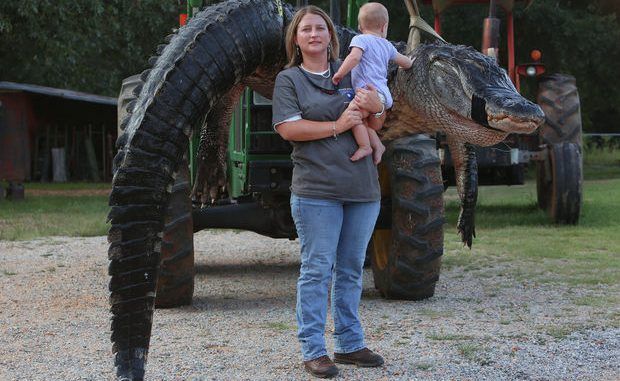
From AL.com (source link): “Let’s get a couple of things out in the open right off the bat; there is no such thing as a 20-foot alligator weighing 1,000 pounds in Alabama or anywhere else for that matter.”
That’s the first line of a gator-season prediction column published on AL.com a day ahead of the beginning of 2014 alligator seasons in Alabama’s southwest and west-central zones.
I wish I’d never written it.

BYPASS THE CENSORS
Sign up to get unfiltered news delivered straight to your inbox.
You can unsubscribe any time. By subscribing you agree to our Terms of Use
Less than 48 hours after it was posted, I was rocking the couch at home while recuperating from the second night of covering the southwest zone gator hunt on and around the Mobile-Tensaw Delta, when I got a call from my buddy “Big Daddy” Lawler in Wilcox County.
“Did you hear about the big one that came in last night?” said Big Daddy, who was broadcasting his “Gettin’ Outdoors Radio” show live from the west-central check-in at Roland Cooper State Park when the massive alligator was towed in on a trailer.
An estimated crowd of 300 people had come to the park that Saturday morning prompted by Lawler to come see wildlife officials attempt to weigh the huge animal.
“No. How big was it?” I asked.
“I sent you a text. It broke the scale. They finally weighed it at 15 feet and 1,011.5 pounds!”
He said that last part real slow, I presume to give it a chance to sink in.
Even in my brain’s sleep-deprived state, it did.
Alabama doesn’t have an alligator state-record program, but I knew off the top of my head the gator killed by Mandy Stokes with the help of her husband John Stokes, brother-in-law Kevin and his children Savannah, 16, and Parker, 14, was much bigger than the largest hunter-killed alligator up to that time.
That 14-foot, 2-inch, 838-pound animal was tagged by Keith Fancher and his crew in 2011, also on the Alabama River.
Mandy Stokes dispatched it after a harrowing five-hour-plus fight in Mill Creek, a tributary of the Alabama River that dumps into it a couple miles above the William Dannelly/Millers Ferry Lock and Dam.
I knew we could be dealing with an animal in a class all its own when a quick Internet search revealed that the current world record as recognized by Safari Club International stood at 14-feet, 8 inches and 880 pounds.
I called photographer Sharon Steinmann, who was supposed to be on the water with me that night covering the local gator hunt. We switched gears and were on the way to Camden within a couple of hours.
Meeting Lawler at the Hardee’s in Camden, he guided us along Wilcox County backroads snaking through beautiful, sparsely populated, agricultural and wooded landscapes of what he called the “raw, rural South” to where the gator was being stored for the night.
Arriving at John Stokes’ dad Winston Stokes’ home in the Sardis community, we were greeted by members of the team and assorted other family and friends.
The big gator was coiled nose-to-tail on a blue tarp and nearly submerged in ice water in the back of a full-size pickup truck. The setting totally masked the true size of the huge animal.
Still, it was hard not to flinch when the tarp was pulled back revealing the width of his back. When Kevin lifted the gator’s head, I knew it was like nothing I’d ever seen before.
I have covered alligator hunts on the Mobile-Tensaw Delta since they began in 2006. I have stood next to dozens of them, including Matt Thornton’s 13-foot, 5-inch, 701-pound one-time state record at the check-in in 2009. I’ve seen untold numbers of big gators swimming in the Delta over the past 34 years.
No other alligator ever made me feel small. The Stokes Gator did as it hung from a tractor boom John Stokes used to lift it from the truck’s bed.
It wasn’t a creepy feeling; nor was I scared.
It was awe, pure and simple.
It was the kind of awe that all you can do is stand there, stupid grin on your face and shake your head, trying futilely to get your brain to accept what your eyes are telling it must be so.
It was a humbling experience just to be standing next to irrefutable proof that such an apex predator was out there when I had convinced myself and so publically stated that it couldn’t be.
People also like stories about ordinary people thrust into extraordinary circumstances.
That’s true here: folks with jobs, kids and bills to pay go gator hunting for the first time and as Mandy Stokes said, “We didn’t go trophy hunting. We just lucked up and got a trophy.”
Maybe that’s why the story continues to resonate with people here and around the world. They’ve become invested in it for their own reasons. That’s always a good thing.
At the same time, I am not naïve enough to believe that the negative reaction had nothing to do with it. The story of the gator’s death reignited the ages-old debate among pro- and anti-hunting segments of the population.
I respect the antis’ right to an opinion, but that doesn’t mean I have to respect the vilest or most hypocritical expressions of it.
Mostly, I reserve the right to ignore it.
The positive response to the hunt story and follow-ups, in which I tried to help folks learn more about alligators than they ever thought they would or maybe ever hoped to, remains gratifying.
It’s also cool to hear people who you know have swamp muck and river water running through their veins say, “You know, I never knew that about an alligator.”
I wrote the first version of the story in 20 minutes back in the Hardee’s parking lot because there wasn’t any Internet service anywhere near Winston Stokes’ home.
I labored over the second, longer version into the wee hours of that Sunday morning while sitting at the desk in Big Daddy’s house.
I knew folks love to read stories about things such as alligators, bears and sharks that can bite them on the backside.
I had no idea how much.
It may be ironic that what could be called the defining story of my 20-year career to this point is about an animal that I didn’t believe existed.
Looking back now, maybe I should take some solace in accurately predicting in the same column that a hunter in the west-central zone would kill the biggest alligator.
I reasoned that those hunters had the best chance of encountering a large animal and were best prepared through past experience to tackle the difficult task of hooking, fighting, securing to the boat and dispatching a truly awe-inspiring alligator.
But “15 feet and 1,011.5 pounds?”
Who could have predicted that?


